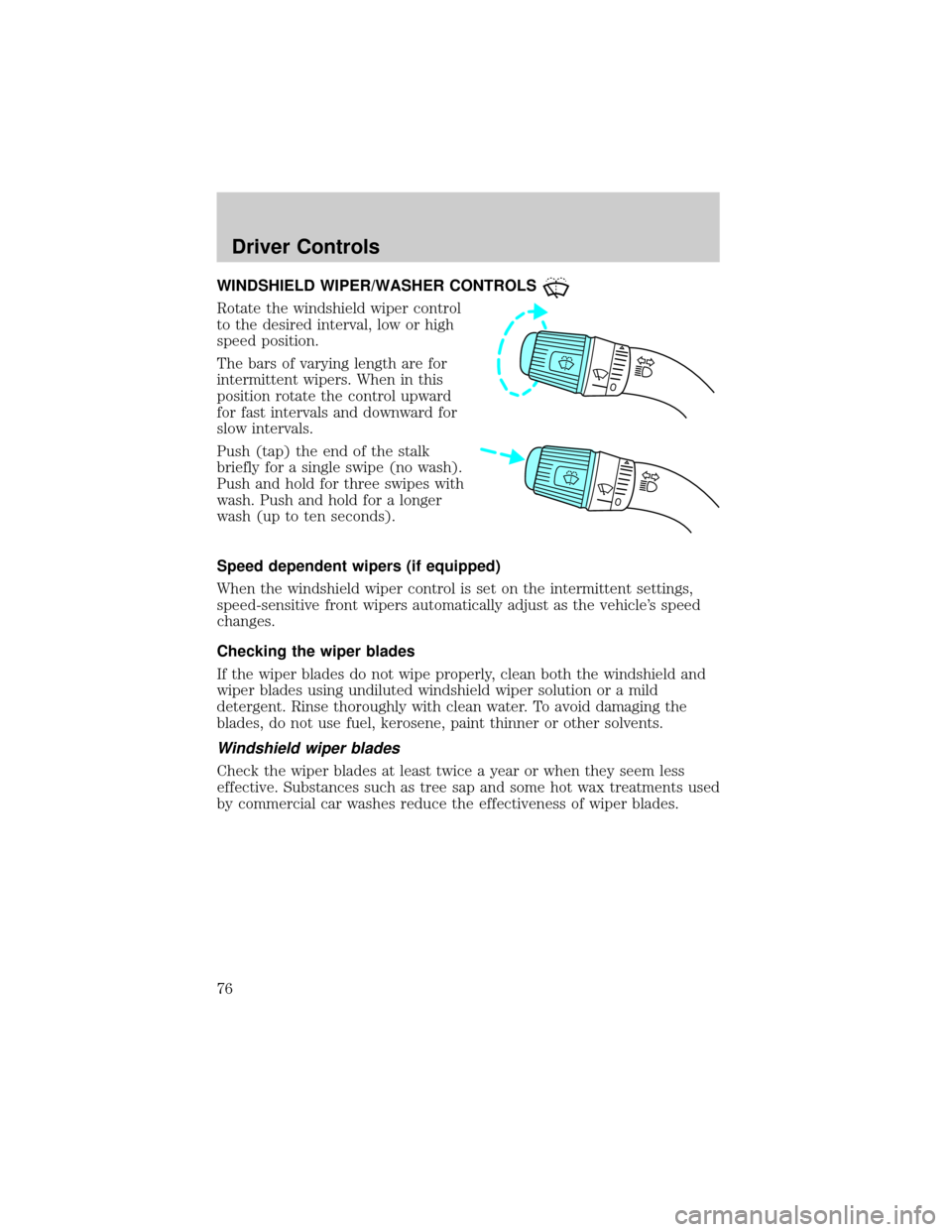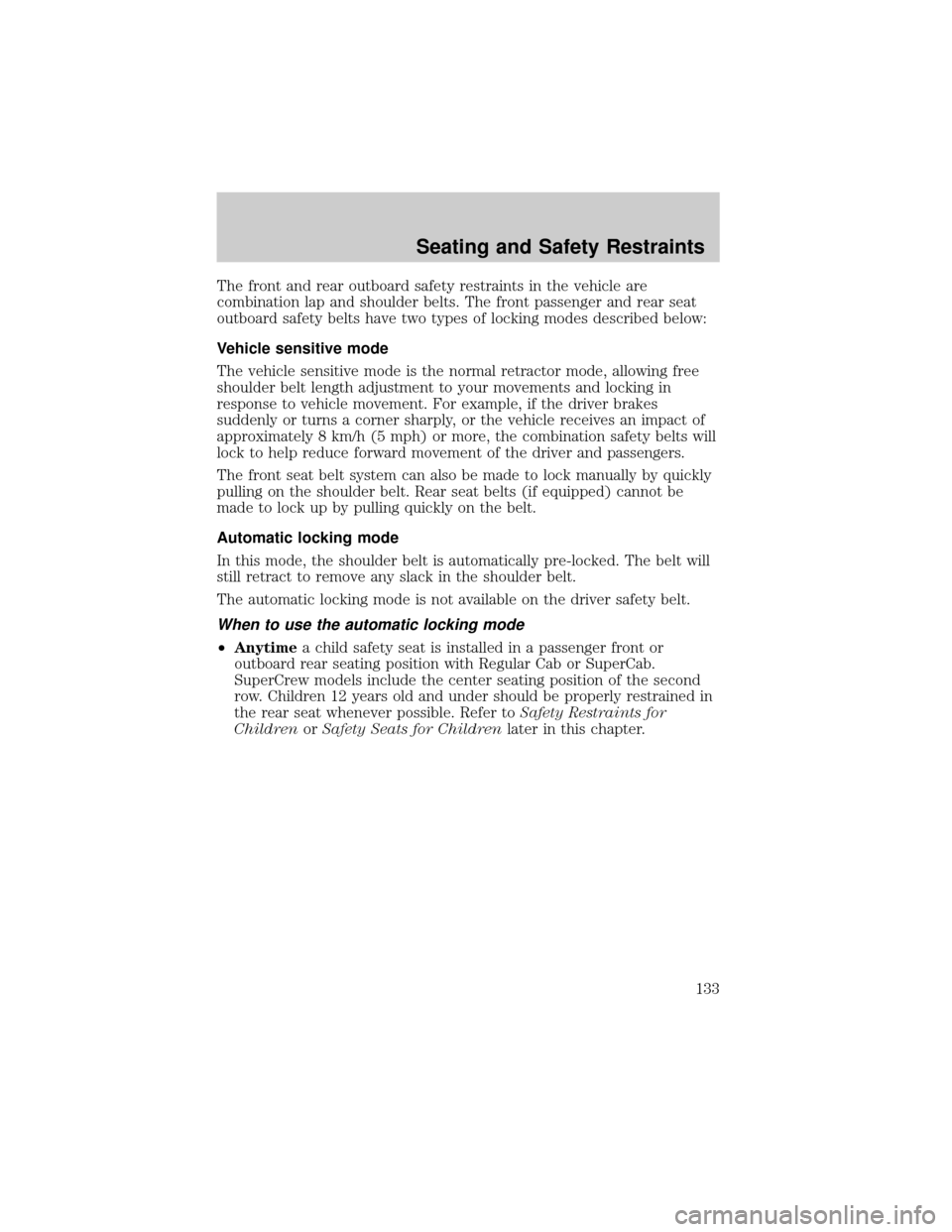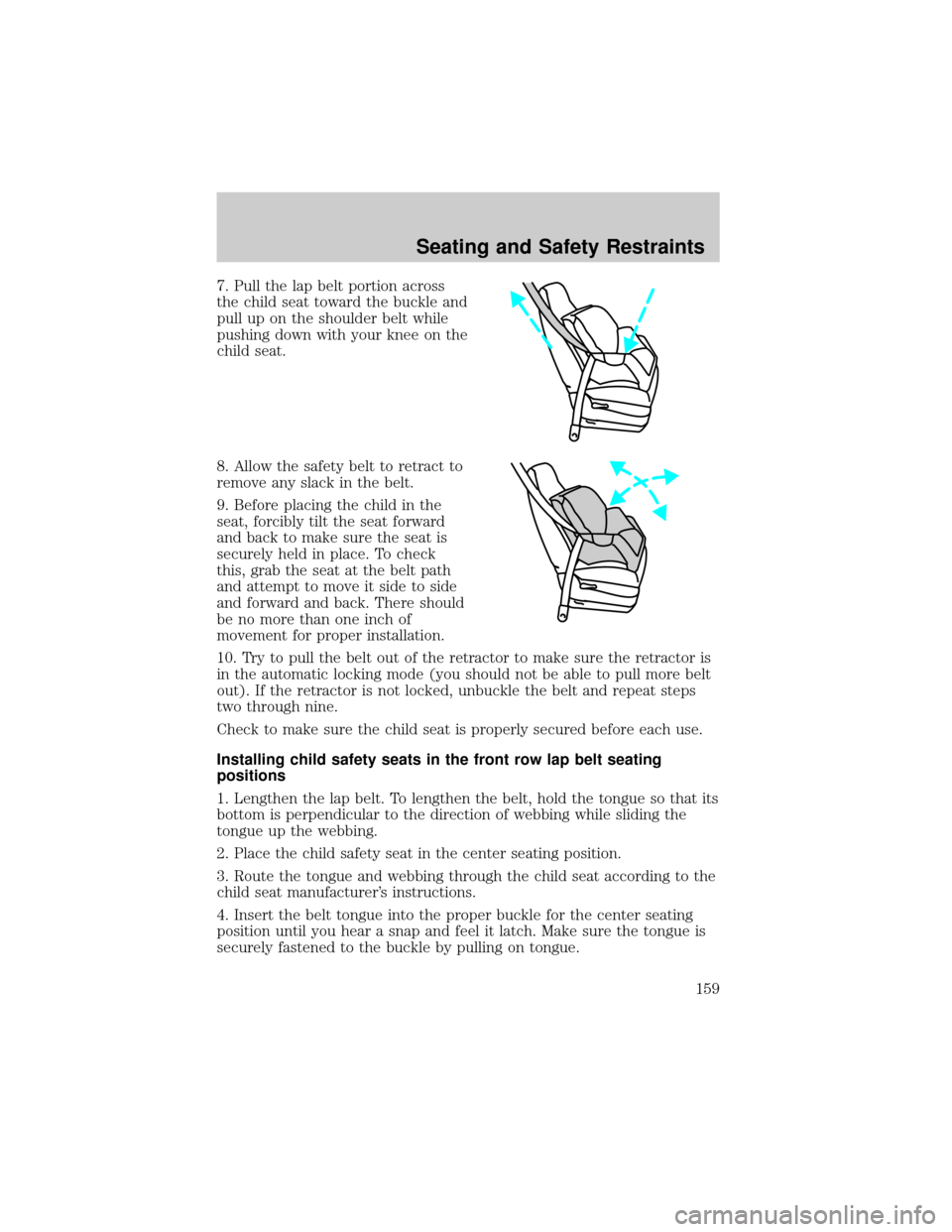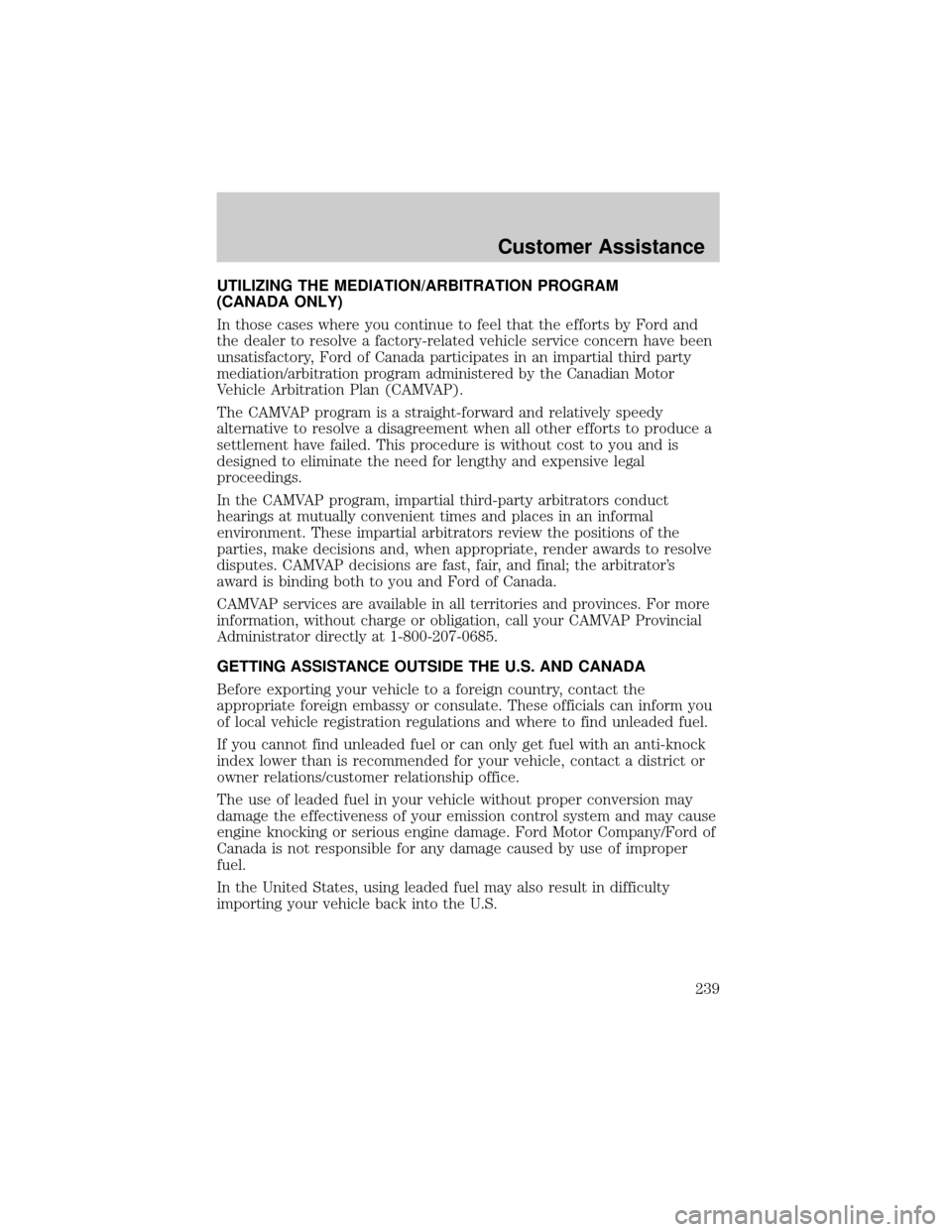2002 FORD F150 length
[x] Cancel search: lengthPage 76 of 320

WINDSHIELD WIPER/WASHER CONTROLS
Rotate the windshield wiper control
to the desired interval, low or high
speed position.
The bars of varying length are for
intermittent wipers. When in this
position rotate the control upward
for fast intervals and downward for
slow intervals.
Push (tap) the end of the stalk
briefly for a single swipe (no wash).
Push and hold for three swipes with
wash. Push and hold for a longer
wash (up to ten seconds).
Speed dependent wipers (if equipped)
When the windshield wiper control is set on the intermittent settings,
speed-sensitive front wipers automatically adjust as the vehicle's speed
changes.
Checking the wiper blades
If the wiper blades do not wipe properly, clean both the windshield and
wiper blades using undiluted windshield wiper solution or a mild
detergent. Rinse thoroughly with clean water. To avoid damaging the
blades, do not use fuel, kerosene, paint thinner or other solvents.
Windshield wiper blades
Check the wiper blades at least twice a year or when they seem less
effective. Substances such as tree sap and some hot wax treatments used
by commercial car washes reduce the effectiveness of wiper blades.
Driver Controls
76
Page 96 of 320

4. The HomeLinktindicator light will flash, first slowly and then rapidly.
When the indicator light begins to flash rapidly, release both buttons.
The previous device has now been erased and the new device can be
activated by pushing the HomeLinktbutton that has just been
programmed.
Canadian Programming
During programming, your hand-held transmitter may automatically stop
transmitting after two seconds which may not be long enough to
program the HomeLinktUniversal Transceiver.
To program your hand-held
transmitters:
²Continue to hold the button on
the HomeLinktUniversal
Transceiver.
²Press and re-press the hand-held
transmitter button every two
seconds until the red light changes from a slow to a fast flash.
Operating TravelNoteT
TravelNotetrecords and stores messages for up to three minutes in total
length with simple controls. When you get an idea or remember
something important while you're driving, you don't have to try to
scribble it down or pull off the side of the road. All you have to do is
push a button and begin speaking.
To record a message:
1. Press and release theREC
buttonone timeto start recording.
(An audible tone will sound,
confirming the onset of recording).
2. Press and release theREC
buttona second timeto end
recording. (An audible tone will
sound again, confirming the end of recording and the red indicator light
will turn off.)
3.
While a message is being recorded, the indicator light will be a solid red.
4. If the message exceeds the available memory space, two tones will
sound, the indicator light will flash amber and recording will end.
The indicator light will flash amber and an ªerrorº tone will sound if the
RECbutton is pressed when memory is full.
REC DEL PLAY
REC DEL PLAY
Driver Controls
96
Page 133 of 320

The front and rear outboard safety restraints in the vehicle are
combination lap and shoulder belts. The front passenger and rear seat
outboard safety belts have two types of locking modes described below:
Vehicle sensitive mode
The vehicle sensitive mode is the normal retractor mode, allowing free
shoulder belt length adjustment to your movements and locking in
response to vehicle movement. For example, if the driver brakes
suddenly or turns a corner sharply, or the vehicle receives an impact of
approximately 8 km/h (5 mph) or more, the combination safety belts will
lock to help reduce forward movement of the driver and passengers.
The front seat belt system can also be made to lock manually by quickly
pulling on the shoulder belt. Rear seat belts (if equipped) cannot be
made to lock up by pulling quickly on the belt.
Automatic locking mode
In this mode, the shoulder belt is automatically pre-locked. The belt will
still retract to remove any slack in the shoulder belt.
The automatic locking mode is not available on the driver safety belt.
When to use the automatic locking mode
²Anytimea child safety seat is installed in a passenger front or
outboard rear seating position with Regular Cab or SuperCab.
SuperCrew models include the center seating position of the second
row. Children 12 years old and under should be properly restrained in
the rear seat whenever possible. Refer toSafety Restraints for
ChildrenorSafety Seats for Childrenlater in this chapter.
Seating and Safety Restraints
133
Page 138 of 320

To lower the shoulder belt height, push the button and slide the height
adjuster down. To raise the height of the shoulder belt, slide the height
adjuster up. Pull down on the height adjuster to make sure it is locked in
place.
Position the shoulder belt height adjusters so that the belt rests
across the middle of your shoulder. Failure to adjust the safety
belt properly could reduce the effectiveness of the seat belt and
increase the risk of injury in a collision.
Lap belts
Adjusting the lap belt
The lap belt should fit snugly and as low as possible around the
hips, not across the waist.
The lap belt tongues are designed to fit only in the correct buckle. The
tongue will not securely latch when using any of the outboard seating
positions buckle. To ensure that you have used the correct buckle you
should hear a snap and feel it latch.
²1st row center and 2nd row center (SuperCab) seating position
The lap belt does not adjust automatically.
Insert the tongue into the correct
buckle (the buckle closest to the
direction the tongue is coming
from). To lengthen the belt, turn the
tongue at a right angle to the belt
and pull across your lap until it
reaches the buckle. To tighten the
belt, pull the loose end of the belt
through the tongue until it fits
snugly across the hips.
Seating and Safety Restraints
138
Page 159 of 320

7. Pull the lap belt portion across
the child seat toward the buckle and
pull up on the shoulder belt while
pushing down with your knee on the
child seat.
8. Allow the safety belt to retract to
remove any slack in the belt.
9. Before placing the child in the
seat, forcibly tilt the seat forward
and back to make sure the seat is
securely held in place. To check
this, grab the seat at the belt path
and attempt to move it side to side
and forward and back. There should
be no more than one inch of
movement for proper installation.
10. Try to pull the belt out of the retractor to make sure the retractor is
in the automatic locking mode (you should not be able to pull more belt
out). If the retractor is not locked, unbuckle the belt and repeat steps
two through nine.
Check to make sure the child seat is properly secured before each use.
Installing child safety seats in the front row lap belt seating
positions
1. Lengthen the lap belt. To lengthen the belt, hold the tongue so that its
bottom is perpendicular to the direction of webbing while sliding the
tongue up the webbing.
2. Place the child safety seat in the center seating position.
3. Route the tongue and webbing through the child seat according to the
child seat manufacturer's instructions.
4. Insert the belt tongue into the proper buckle for the center seating
position until you hear a snap and feel it latch. Make sure the tongue is
securely fastened to the buckle by pulling on tongue.
Seating and Safety Restraints
159
Page 239 of 320

UTILIZING THE MEDIATION/ARBITRATION PROGRAM
(CANADA ONLY)
In those cases where you continue to feel that the efforts by Ford and
the dealer to resolve a factory-related vehicle service concern have been
unsatisfactory, Ford of Canada participates in an impartial third party
mediation/arbitration program administered by the Canadian Motor
Vehicle Arbitration Plan (CAMVAP).
The CAMVAP program is a straight-forward and relatively speedy
alternative to resolve a disagreement when all other efforts to produce a
settlement have failed. This procedure is without cost to you and is
designed to eliminate the need for lengthy and expensive legal
proceedings.
In the CAMVAP program, impartial third-party arbitrators conduct
hearings at mutually convenient times and places in an informal
environment. These impartial arbitrators review the positions of the
parties, make decisions and, when appropriate, render awards to resolve
disputes. CAMVAP decisions are fast, fair, and final; the arbitrator's
award is binding both to you and Ford of Canada.
CAMVAP services are available in all territories and provinces. For more
information, without charge or obligation, call your CAMVAP Provincial
Administrator directly at 1-800-207-0685.
GETTING ASSISTANCE OUTSIDE THE U.S. AND CANADA
Before exporting your vehicle to a foreign country, contact the
appropriate foreign embassy or consulate. These officials can inform you
of local vehicle registration regulations and where to find unleaded fuel.
If you cannot find unleaded fuel or can only get fuel with an anti-knock
index lower than is recommended for your vehicle, contact a district or
owner relations/customer relationship office.
The use of leaded fuel in your vehicle without proper conversion may
damage the effectiveness of your emission control system and may cause
engine knocking or serious engine damage. Ford Motor Company/Ford of
Canada is not responsible for any damage caused by use of improper
fuel.
In the United States, using leaded fuel may also result in difficulty
importing your vehicle back into the U.S.
Customer Assistance
239
Page 302 of 320

VEHICLE DIMENSIONS
Styleside
DimensionBody Style
Regular
Cab 4x2Regular Cab
4x4Super Cab
4x2Super Cab
4x4
(1) Overall
length5 256 mm
(206.9 in)
(SWB)
5 729 mm
(225.5 in)
(LWB)5 264 mm
(207.2 in)
(SWB)
5 736 mm
(225.8 in)
(LWB)5 728 mm
(225.5 in)
(SWB)
6 201 mm
(244.1 in)
(LWB)5 735 mm
(225.8 in)
(SWB)
6 208 mm
(244.4 in)
(LWB)
(2) Overall
width1 989mm
(78.3 in)
12 019 mm
(79.5 in)11 989 mm
(78.3 in)12 019 mm
(79.5 in)1
(3) Overall
height1 846 mm
(72.7 in)
(SWB)
1 838 mm
(72.4 in)
(LWB)1 915 mm
(75.4 in)
(SWB)
1 907 mm
(75.1 in)
(LWB)1 849 mm
(77.8 in)
(SWB)
1 841 mm
(75.5 in)
(LWB)1 918 mm
(75.5 in)
(SWB)
1 907 mm
(75.1 in)
(LWB)
(4) Wheel
base3 045 mm
(119.9 in)
(SWB)
3 518 mm
(138.5 in)
(LWB)3 053 mm
(120.2 in)
(SWB)
3 526 mm
(138.8 in)
(LWB)3 518 mm
(138.5 in)
(SWB)
3 990 mm
(157.1 in)
(LWB)3 526 mm
(138.8 in)
(SWB)
3 998 mm
(157.4 in)
(LWB)
(5)Track
front/rear1 661 mm
(65.4 in)
1 661 mm
(65.4 in)1 661 mm
(65.4 in)
1 661 mm
(65.4 in)1 661 mm
(65.4 in)
1 661 mm
(65.4 in)1 661 mm
(65.4 in)
1 661 mm
(65.4 in)
1Vehicle width, including mirrors: 2 279 mm (89.7 in)
Maintenance and Specifications
302
Page 303 of 320

Flareside
DimensionBody Style
Regular
Cab 4x2Regular
Cab 4x4Super Cab
4x2Super Cab
4x4
(1) Overall
length5 255 mm
(206.9 in)5 263 mm
(207.2 in)5 728 mm
(225.5 in)5 735 mm
(225.8 in)
(2) Overall
width2 014 mm
(79.3 in)
12 030 mm
(79.9 in)12 014 mm
(79.3 in)12 030 mm
(79.9 in)1
(3) Overall
height1 846 mm
(72.7 in)1 915 mm
(75.4 in)1 849 mm
(72.8 in)1 918 mm
(75.5 in)
(4) Wheel
base3 046 mm
(119.9 in)3 053 mm
(120.2 in)3 518 mm
(138.5 in)3 526 mm
(138.8 in)
(5) Track
front/rear1 661 mm
(65.4 in)1 661 mm
(65.4 in)1 661 mm
(65.4 in)1 661 mm
(65.4 in)
1Vehicle width, including mirrors: 2 279 mm (89.7 in)
Maintenance and Specifications
303